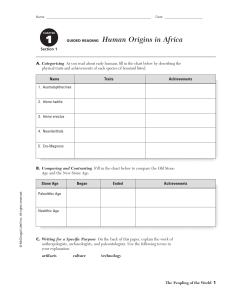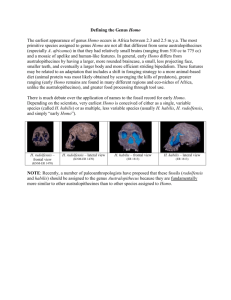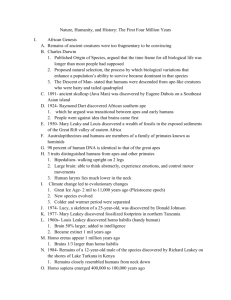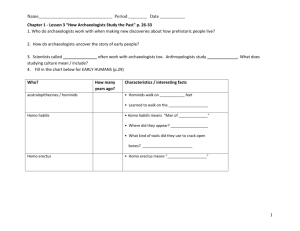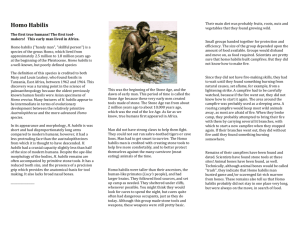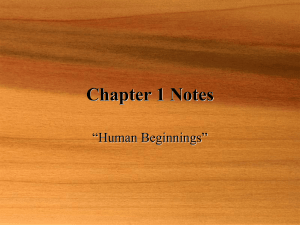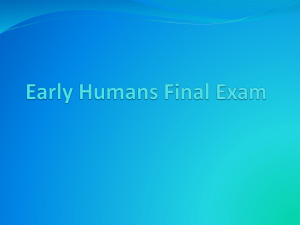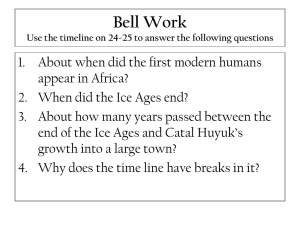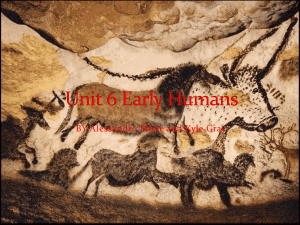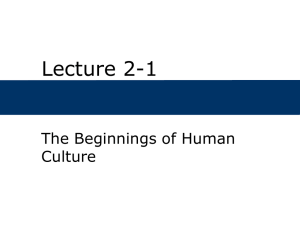Early Humans
advertisement
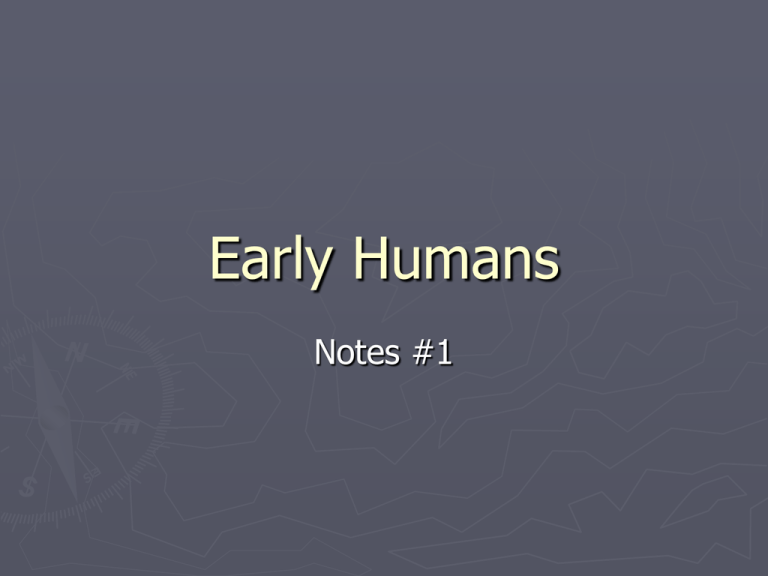
Early Humans Notes #1 Class Objective ► We will investigate how we locate and study early human life forms. Vocabulary Terms for Africa ► ► ► 1. Hominid: Primate mammal—bipedal (uses two feet), stands upright (Lucy: 3-6 million years ago) 2. Hunter-gatherer: food is maintained by hunting, fishing, and foraging 3. Evolution: A gradual process in which something changes into a different and usually more complex or better form. ► Synonyms: ► A. Process ► B. Gradual ► Biology: development of development development Change in the genetic composition of a population during successive generations, as a result of natural selection acting on the genetic variation among individuals, and resulting in the development of new species. Vocabulary cont. ► Natural Selection: The process in nature where only the organisms best adapted to their environment tend to survive and transmit their genetic characteristics in increasing numbers to succeeding generations while those less adapted tend to be eliminated. SURVIVAL OF THE FITTEST. Vocabulary cont. ► Archeologists: scientists who learn about early people by excavating and studying the traces of early settlements. ► Anthropologists: Study ancient cultures. They examine the artifacts at archeological digs. After studying the evidence they recreate a picture of how early humans culture may have been. ► Paleontologists: Study fossils Evidence of early life preserved in rocks. ► Human skulls. fossils usually consist of fragments of teeth, bones or Vocabulary Cont. ► Artifacts: Old object that can tell you something about a people ► Culture: All of the features that make up a person’s way of life ► Technology: Ways of applying knowledge, tools, and inventions to meet needs. EARLY HOMINIDS Australopithecines ► ► ► In the mid 1970’s an archeologist, led a scientific expedition to the region of Laetoli in Tanzania, in East Africa. In 1978 they found prehistoric footprints that resembled those of modern humans. The footprints were made by humanlike beings now called australopithecines. Mary Leakey working at the Laetoli, Tanzania, site where fossil footprints were found, 1978. Australopithecines: 4 million to 1 million B.C. ► TRAITS: Opposable thumbs, two feet ► ACHIEVEMENTS: They were the first humanlike creature to walk upright. ► During the same time an American anthropologist Donald Johanson and his team were looking for fossils in Ethiopia. His team discovered an adult female skeleton. They named her Lucy She lived around 3.5 million years ago. Opposable Thumbs ► These early hominids had already developed the opposable thumbs. ► Why are opposable thumbs an advantage? Homo Habilis: 2.5 million years ago ► Before the australopithecines eventually vanished, new hominids appeared in East Africa around 2.5 million years ago. ► In 1960, Mary and Louis Leakey discovered a hominid fossil at Olduvai called George. ► They named the fossil Homo Habilis Homo Habilis ► Homo Habilis means man of skill. ► TRAITS: small brain ACHIEVEMENTS: First tool maker (butcher) ► Homo habilis used tools to cut meat and crack open bones. The stone blades they used could butcher a elephant. Homo Erectus: 1.6 million years ago ► ► ► ► This species is known as upright man. Some anthropologists believe Homo Erectus was more intelligent than the previous species. TRAITS: Larger brain=smarter ACHIEVEMENTS: Fire, Language, migrate (move about) Neanderthals: ► Scientist traditionally classified Neanderthals as ancestors to modern humans. ► But in 1997, DNA tests on a Neanderthal Skelton indicated they were not ancestors of modern humans. Neanderthals ► TRAITS: They were powerfully built with heavy slanted brows, well-developed muscles, and thick bones. ► ACHIEVEMENTS: They had complex social systems and tried to control and understand their world—developed religion and temporary shelters Neanderthal’s ► Neanderthal’s disappeared about 30,000 years ago. Cro- Magnons: 40,000 years ago ► ► TRAITS: Similar to humans ACHIEVEMENTS: CroMagnons used superior hunting strategies that may have aided in their survival. They studied and stalked their prey. They also advanced in skills such as the spoken language. ► Scientists believe that Homo Erectus evolved into Homo Sapiens ► Homo Sapiens had much larger brains than their predecessors . Homo Sapiens: Today The Old Stone Age Paleolithic Age ► Some of the most important developments of all time are the invention of tools, mastery of fire, and the development of language. Old Stone Age: Paleolithic Age ► WHEN: The early part of the Old Stone Age is also referred to as the Paleolithic age, and lasted from about 2.5 million to 8000 B.C. ► ACHIEVEMENTS: Made stone tools Old Stone Age: Paleolithic Age ► Much of the Paleolithic age occurred during the period called the Ice Age. ► During this time glaciers alternately advanced and retracted as many as 18 times. ► The ice age ended about 10,000 years ago. New Stone Age: Neolithic Age ► WHEN: began about 8,000 B.C. and lasted to near 3,000 B.C. ► ACHIEVEMENTS: People who lived during that era learned to polish stone tools, make pottery, grow crops, and raise animals.
